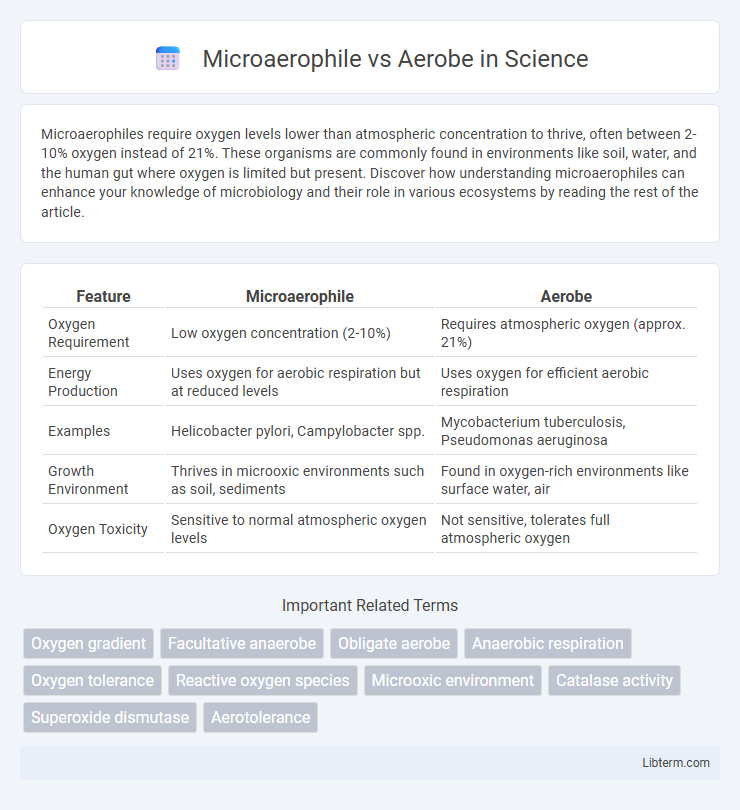Microaerophiles require oxygen levels lower than atmospheric concentration to thrive, often between 2-10% oxygen instead of 21%. These organisms are commonly found in environments like soil, water, and the human gut where oxygen is limited but present. Discover how understanding microaerophiles can enhance your knowledge of microbiology and their role in various ecosystems by reading the rest of the article.
Table of Comparison
| Feature | Microaerophile | Aerobe |
|---|---|---|
| Oxygen Requirement | Low oxygen concentration (2-10%) | Requires atmospheric oxygen (approx. 21%) |
| Energy Production | Uses oxygen for aerobic respiration but at reduced levels | Uses oxygen for efficient aerobic respiration |
| Examples | Helicobacter pylori, Campylobacter spp. | Mycobacterium tuberculosis, Pseudomonas aeruginosa |
| Growth Environment | Thrives in microoxic environments such as soil, sediments | Found in oxygen-rich environments like surface water, air |
| Oxygen Toxicity | Sensitive to normal atmospheric oxygen levels | Not sensitive, tolerates full atmospheric oxygen |
Introduction to Microaerophiles and Aerobes
Microaerophiles are microorganisms that require oxygen levels lower than atmospheric concentration, typically around 2-10%, for optimal growth, differentiating them from aerobes that thrive in normal atmospheric oxygen levels of about 21%. Aerobes utilize oxygen for aerobic respiration, efficiently producing energy by converting glucose and oxygen into carbon dioxide, water, and ATP. Microaerophiles possess specialized enzymes to survive in low-oxygen environments, avoiding oxygen toxicity that can inhibit their growth compared to aerobes with robust oxidative stress defenses.
Defining Microaerophiles
Microaerophiles are microorganisms that require oxygen to survive but at lower concentrations than are present in the atmosphere, typically between 2% to 10% oxygen. They thrive in environments with reduced oxygen levels, unlike aerobes, which need atmospheric oxygen levels around 21% for optimal growth. Microaerophiles possess specialized enzymes to protect against oxidative damage caused by higher oxygen concentrations.
Defining Aerobes
Aerobes are microorganisms that require oxygen for growth and energy production, utilizing aerobic respiration to efficiently generate ATP. Unlike microaerophiles, which need oxygen at lower concentrations, aerobes thrive in environments with atmospheric oxygen levels, typically around 21%. This oxygen dependency distinguishes aerobes from anaerobic organisms that either tolerate or are harmed by oxygen exposure.
Oxygen Requirements: Microaerophile vs Aerobe
Microaerophiles require oxygen levels lower than atmospheric concentration, typically around 2-10%, to survive and grow, as excessive oxygen can be toxic to them. Aerobes depend on normal atmospheric oxygen levels (about 21%) for cellular respiration and energy production. Both types utilize oxygen but differ in their tolerance and optimal oxygen environments.
Metabolism and Energy Production Differences
Microaerophiles utilize oxygen at lower concentrations than atmospheric levels, employing oxidative phosphorylation with limited oxygen as the final electron acceptor, optimizing energy yield under micro-oxygen conditions. Aerobes rely on abundant oxygen to drive complete aerobic respiration, maximizing ATP generation via the electron transport chain. The key metabolic difference lies in oxygen dependency levels and the efficiency of ATP production through their respective electron transport mechanisms.
Typical Habitats and Environmental Adaptations
Microaerophiles typically inhabit environments with low oxygen concentrations such as soil layers, stagnant water, and the gastrointestinal tracts of animals, adapting to microaerobic conditions by utilizing oxygen at reduced levels for metabolism. Aerobes thrive in oxygen-rich habitats including surface soils, freshwater, and marine environments, where they employ aerobic respiration for efficient energy production. Both groups have evolved specialized enzymes like superoxide dismutase and catalase to manage oxidative stress, but microaerophiles often possess adaptations for limited oxygen tolerance, whereas aerobes have robust mechanisms for high oxygen exposure.
Key Examples of Microaerophiles and Aerobes
Microaerophiles such as Helicobacter pylori and Campylobacter jejuni thrive in environments with reduced oxygen levels, typically around 5% O2. Obligate aerobes like Mycobacterium tuberculosis and Pseudomonas aeruginosa require atmospheric oxygen concentration near 21% O2 for optimal growth. These examples highlight the oxygen preference differences critical for their metabolic processes and survival niches.
Laboratory Cultivation and Growth Conditions
Microaerophiles require oxygen concentrations lower than atmospheric levels, typically 2-10%, for optimal growth and are often cultured using specialized gas-generating packs or controlled incubators to maintain reduced oxygen environments. Aerobes thrive in atmospheric oxygen concentrations around 21% and can be easily cultivated on standard nutrient agar plates or broth under normal laboratory conditions with ample aeration. Accurate oxygen level control is critical for microaerophiles, whereas aerobes demonstrate robust growth under ambient air without the need for modified atmospheric conditions.
Medical and Industrial Relevance
Microaerophiles such as Helicobacter pylori play a critical role in medical microbiology due to their involvement in gastrointestinal diseases and targeted antibiotic therapies. Aerobes including Bacillus subtilis are essential in industrial applications for their ability to efficiently produce enzymes and vitamins in aerobic bioreactors. Understanding the oxygen requirements of these microorganisms enables optimized cultivation strategies for pharmaceutical manufacturing and infection control.
Summary: Comparing Microaerophiles and Aerobes
Microaerophiles require oxygen at lower concentrations (typically 2-10%) than atmospheric levels for optimal growth, whereas aerobes thrive in atmospheric oxygen levels (around 21%). Both rely on oxygen for respiration, but microaerophiles possess enzymes that protect against oxidative damage at reduced oxygen concentrations, unlike strict aerobes which tolerate and utilize higher oxygen levels efficiently. Understanding these oxygen preferences is crucial for cultivating these organisms in laboratory or industrial microbiology settings.
Microaerophile Infographic

 libterm.com
libterm.com